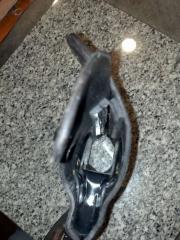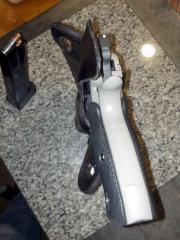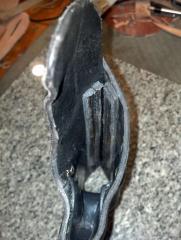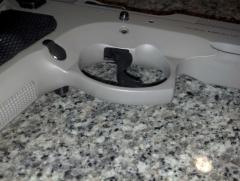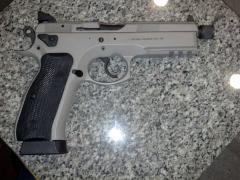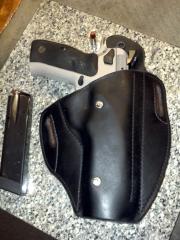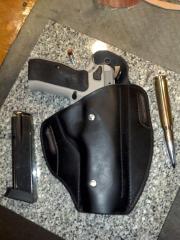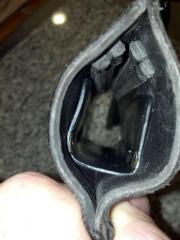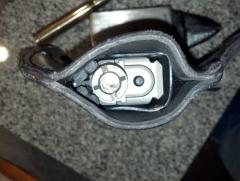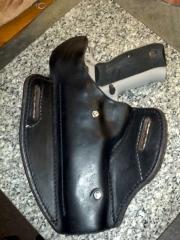-
Posts
80 -
Joined
-
Last visited
Content Type
Profiles
Forums
Events
Blogs
Gallery
Everything posted by CowboyDan
-
I built a boot holster for a little gun, with a strap that went above the calf. It wasn't until a couple of weeks later that I realized why my leg was so blasted ITCHY in the evening. Turns out the itchy area was exactly where the strap was. I replaced the strap with a different type of leather, still itchy. It wasn't like it was chafing, this was a reaction to something. If I wore it for an evening, that band around my leg would itch for 2-3 days. Haven't worn it since. I still need to find another piece of leather to try, maybe some sort of thin lining. I'll get to it eventually. Could be the neatsfoot oil I used, but I kinda doubt it. The oil doesn't seem to bother my hands or arms when I get it on me.
-
Something to consider is how a lady uses her purse. If she tends to sit the purse down or leave it out of reach in public, then a concealed carry purse may not be the best solution. For instance, a friend of mine recently was at the grocery store and had her purse sitting in the kiddy seat directly in front of her (within arms reach) as she was pushing it to her car. A thief ran by her while she was unlocking the car and grabbed it. The thief got away. The same thief used the same method at several other local stores in the following weeks. Had my friend been carrying in her purse, the thief possibly could have changed to armed robbery. On the flip side of that, if a lady decides to use a concealed carry purse, she should take extra measured to make sure she always has the purse held, carried, or stored such that it can't be just grabbed (such out of the kiddy seat of a grocery cart). One other thing: Some purses use velcro on the inside to accommodate different size holsters. If you decide to do anything like that, make sure you make the purse/holsters such that only the loop portion is exposed, and get the edges fastened down. The hooks or the edges of the backing material can jam under fingernails when reaching in hurriedly. A friend's wife found that out the hard way.
-
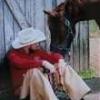
Dummy Bullets
CowboyDan replied to AEMcClain's topic in Gun Holsters, Rifle Slings and Knife Sheathes
I would be willing to bet that there's more than one hunter out there with one of those calibers that would be willing to give you a cartridge or two in exchange for a nice sling or cartridge case. Maybe if you ask at the local gun shop, they usually know local folks with somewhat more unusual calibers like that (assuming the local folks frequent the shop). If you go that route, it would be worth keeping in mind that some guys that reload for rifles won't do a full length resize on their cartridges every time. This makes the cartridge more specific to their rifle (better accuracy, more consistent, etc...), but which could throw off your mold just a hair. Probably not enough to worry about for most leather work, but something to be aware of. -
I had an interesting holster to make. It's a CZ 75 SP-01 Tactical Suppressor Ready. Which means it has a rail (wants to eat the leather) and really tall sights (wants to eat the leather) that have Tritium inserts (super cool in low light). Also, being a 'tactical' model, it has a decocker instead of a safety (not that the holster cares). Which, if you've never handled one, means it is very disconcerting to see the hammer fall when you hit the 'safety'. But, it handles really nice. The beast: Knowing that the rail would tear up the inside of the holster, I knew it would need an insert of some sort. So I decided to try my hand at some Kydex and see how that went. And because of the tall sights, I would need a stitched sight channel. So, this called for an experimental holster (throw-away). And boy was I right. So, I started w/ the fill size 1911 pancake pattern that JLS provides for free from his website (http://www.jlsleather.com/diy/holster-patterns-diy/ THANKS!!!) and added some length in a couple of spots to accomodate the larger gun. Then molded some Kydex (about 0.080 inch thick) fairly close around the gun from just past the end of the frame to almost the top of the front panel, including the trigger guard (for retention). Turns out that molding it fairly tight was NOT a good idea, but more on that in a moment. So then I stitched about where I thought the stitch line needed to be along the bottom of the gun (along the bottom of the rail, and around trigger guard), and wet-formed along the stitch line using the gun in the Kydex. Once that was dry, I glued the kydex in place w/ rubber cement and added two rivets (A little more on those later). Then built a really fancy sight channel insert that would hold the front & back leather panels in place and keep the sights from being damaged or damaging the holster. The fancy sight channel was a BAD idea. Not only is it REALLY hard to stitch through 7 layers of 6/7 oz leather by hand, it didn't work near as well as I had hoped. But, it was a good try. Once the sight channel was stitched in, I stuck the gun in and it clicked in place REALLY nicely. AWESOME retention. Turns out the retention was TOO good. I almost couldn't get it back out. Here's where that Kydex molding note comes back into the picture. Let's look at the gun: See how the frame at the back of the rail is beveled down to the trigger guard width? Well, turns out that once the gun is in and try to remove it, the rail hits on the Kydex that is molded to that bevel. OOPS! I should have seen that coming. So, I had to make a model of the lower part of the frame, trigger guard, and grip, BUT without the bevel. This makes for a sharp corner in the Kydex, but as long as it is molded to the trigger guard, and VERY SLIGHTLY into the trigger guard, it will still hold fairly well. The addition of the leather to the Kydex once everything is assembled in essence makes the Kydex much stiffer. Also, when molding the Kydex, make sure you add little bulges where the rivets go so that they don't make contact with the gun itself. In the area of the rail it might not be too critical, depending on the customer, but up around the trigger guard you don't want to scratch it up unnecessarily. Since the semi-solid sight channel idea wasn't working, I tore out the sight channel stitches and tried again. This time with two pieces of about 4/5 oz on each side of the front sight and touching the top of the slide. This worked a lot better, so I decided to go with that idea. At this point I also trimmed the sweat guard and muzzle end of the holster. After tearing the whole holster apart, I used the stitch lines to lay out the belt slots positions and the edges by referencing the stitch lines in the JLS pattern. Then, using the experimental holster, I sketched the bottom of the holster and sweat guard. Once that was sketched, I could add smoothing lines and contours to make it look a little prettier. Stitched w/ Tiger thread, my first time using it. I tried black around the edges and sight channel, and white on the inside portion of the belt slots. Finish is Vinegaroon and Mop-N-Glo. The result is what you see here. Since this is based so heavily on the JLS pattern, and he was generous enough to make it available to all, I thought I should do the same with what I came up with. So I scanned in my pattern and it is attached to this post. It is a 1-to-1 scale, and I added some reference dimensions that you can use to check that it printed to the correct size. Also, in case anyone needs dimensions for molding a mag pouch, those are also attached. CZ_75_SP-01_18rd-Mag-dims.pdf CZ_75_SP-01_Holster-Back-Panel.pdf CZ_75_SP-01_Holster-Front-Panel.pdf CZ_75_SP-01_Mag-pouch.pdf
-
From the album: CZ 75 SP-01
-
From the album: CZ 75 SP-01
-
From the album: CZ 75 SP-01
-
From the album: CZ 75 SP-01
-
From the album: CZ 75 SP-01
-
From the album: CZ 75 SP-01
-
From the album: CZ 75 SP-01
-
From the album: CZ 75 SP-01
-
From the album: CZ 75 SP-01
-
From the album: CZ 75 SP-01
-

Tactical Leather Rig
CowboyDan replied to Treed's topic in Gun Holsters, Rifle Slings and Knife Sheathes
I've been studying your pictures a little more, and have some questions: Is the drop holster leg strap adjustable? Is the kydex insert in the holster part, or the drop-leg part? -

Tactical Leather Rig
CowboyDan replied to Treed's topic in Gun Holsters, Rifle Slings and Knife Sheathes
I think I may be making one like this. I've been contemplating it, but hadn't figured out how to do the holster & AR pouch. I really like how you did those. -
Howdy, & welcome. That is definitely an interesting design. Your idea for the lower attachment isn't bad. How it loops through the two holes to pull against multiple layers of leather I think will work well. But, you upper attachment points aren't going to last very long. The dog leash clips (that's what I've seen them on mostly, I don't know what the real name is for them) will elongate the holes in the leather pretty quickly, then SNAP! And suddenly your holster is flopping around. Not fun. One better way would be to add a wide loop to the top of the holster, and have a rectangular steel ring in it. The nylon would then loop through that, kind of like the strap attachments on a laptop bag. That way the stress is spread out over a wider area and distributed evenly. You will want to use a stitching groover tool. If you're cheap & creative, you can make one from a big nail. But it's probably better for the first time to buy one. When you make the groove, it not only gives you a guide for placing the awl (to keep the lines nice & straight), but it also insets the thread so it doesn't become the high point and wear through. Thicker thread requires a deeper groove to protect it. I have a belt that I wear that when I stitched it, I used thread that was really too big. So 3 1/2 years later the thread is wearing through. I'll have to re-stitch it sometime in the next few months. This time I'll use a slightly smaller thread. Are those Trijicon sights? Did you get the Tritium ones?
-
Thanks to all. I ordered some sample cards from YinTx. Man, that thread looks sooooo much better quality than what I got from springfield. If nothing else, it's much more consistent diameter.
-
It sounds like I just got a crappy batch of thread. Is there a place that will sell/give samples of the threads, or at least sell in small amounts? I don't really want to buy a whole spool just to find out it doesn't work like I expected. 1-2 yards per sample would be plenty.
-
To start off with, I've only used 3 different threads to do my stitching (all hand, no machine). - The overly waxed stuff from Tandy (BLEH!) - Nicely pre-waxed thread (I think it's cotton?) from Springfield (too large for what I'm doing now) - Pre-waxed linen from Springfield The problem I'm having is the linen thread seems to snap really easily sometimes. The first little spool I tried was ordered last year sometime. I found I couldn't put near the tension on it that I could the cotton thread, but that was a good thing as it kept me from slicing between stitching holes with the thread. It would still snap occasionally, but generally I could go several feet of stitching before it happened, and even then it was probably because I was putting a little too much tension on it. I finally finished off that spool, so I ordered some more. But this stuff seems to be really prone to snapping. It looks the same as the first spool, but I can't seem to get stitches tight before it snaps. It almost always snaps right at the hole I just pulled it through, but it can be either thread (left or right). I think the longest I've been able to go without a snap is 3-4 inches. And that was in some 3-4 oz vegtan w/ the small Bob Douglas awl. The worst I've had was last night I got 3-4 holes and SNAP! That happened a couple times in a row, and I gave up and got something to eat. So my question is; What in the world is going on!?!?!? Am I doing something wrong? Is linen thread normally this inconsistent in how much tension it will hold? Is this typical behavior of thread (linen or otherwise) from Springfield? (Disclaimer: I've not had any trouble with anything I've gotten from them before this, including the 2 large spools of pre-waxed cotton thread) I really liked the first linen spool I had. It was the perfect size for 90% of what I do, held tension well, wasn't overly waxed, and didn't snap unless I got carried away with pulling tight.
-

Mini Swivelknife Holster
CowboyDan replied to jan3ll3's topic in Gun Holsters, Rifle Slings and Knife Sheathes
I like it. Is it supposed to fit around something in particular (your arm??), or just hang and look cool holding the knives? -
Lol. I can't tell you how glad I am that the kitten is optional. I don't mind cats, but I've only met one that didn't become a giant blur of teeth and claws around me. Thanks for putting the tutorial together. I like your humorous additions.
-

P938 First Real Holster
CowboyDan replied to Cornbread's topic in Gun Holsters, Rifle Slings and Knife Sheathes
I just made my first holsters, and I know you could have done a LOT worse (like me!). A groover and over stitching wheel (sometimes called pricking wheel, though those are sometimes a different tool) are absolutely invaluable to me in stitching. The fuzzy side can be burnished down a bit to smooth it out if it's exposed. A piece of smooth wood (sanded paint stir stick), tempered glass, etc.. will work. If it's really bad then you will need to use a skiver to shave it off and get it somewhat smooth even if it's going to get glued to something. I've been told that this is more of a problem on the cheap leather than the higher end hides. I believe it. I had some really thick stuff a while back that was terrible on the backside (large flakes coming off & kinda stringy) and had to skiver it off just to get the contact cement to hold the hide in place.



